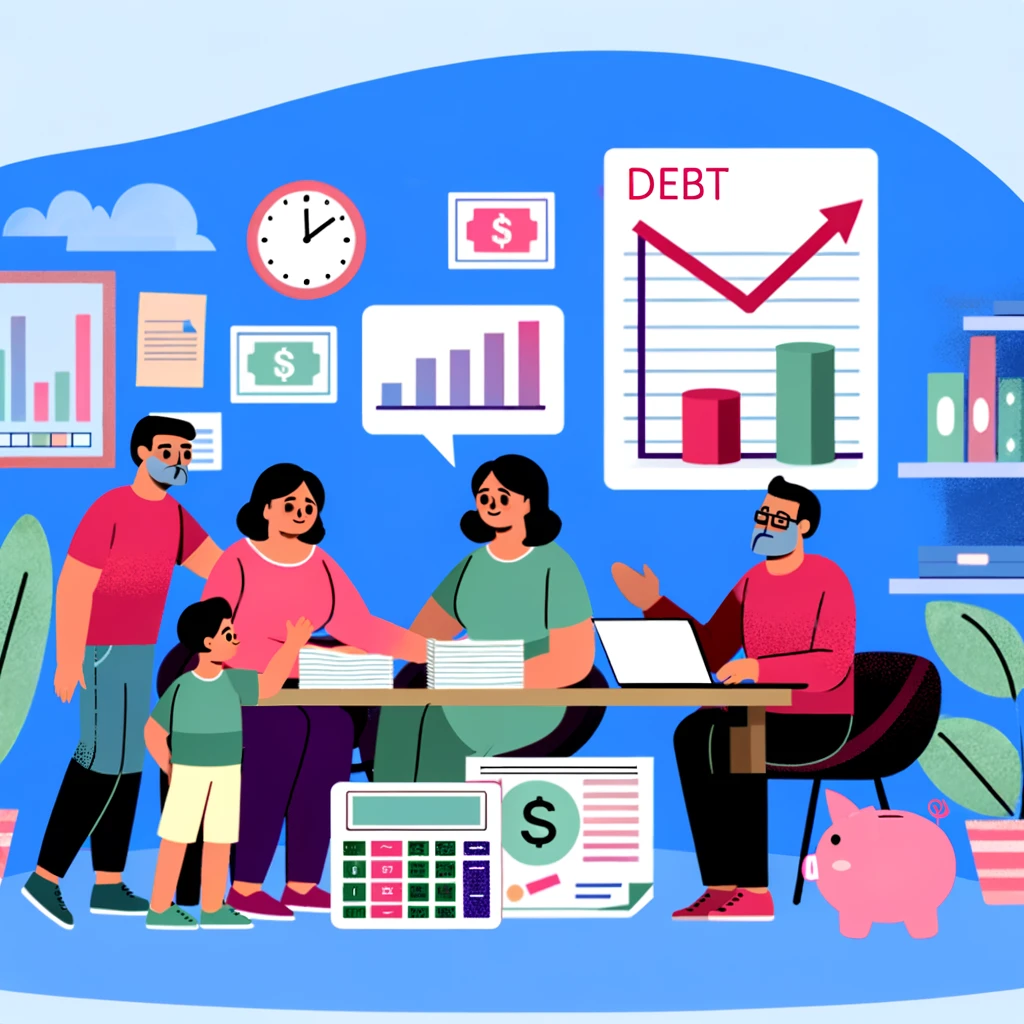Introduction
In the current financial environment, where carrying debt has become a widespread reality for numerous households, devising effective methods to control and eliminate this financial pressure is more important than ever. Be it from credit cards, educational loans, home mortgages, or personal borrowing, the burden of family debt can deeply affect your financial health and sense of tranquility. Nonetheless, progressing towards financial independence is not only achievable but can be attained with a deliberate plan and positive attitude. This guide is designed to offer families a detailed plan to evaluate their debt, establish attainable objectives, and implement tested debt-reduction techniques. From devising a specific family budget to deciding between debt repayment strategies like the snowball or avalanche methods, negotiating with lenders, or even identifying opportunities to increase earnings, we will address all the crucial steps to confront family debt directly. Join us on this path, aiming for a debt-free existence that lays the groundwork for financial stability and well-being.
Understanding Family Debt
Family debt encompasses a wide range of financial obligations that a household accumulates over time. It’s not just about the numbers on your bills; it’s about understanding the nature and structure of these debts to strategize effectively for their repayment. Common types of family debt include:
- Mortgages: Often the largest portion of household debt, representing loans taken out to purchase a home.
- Car Loans: Loans specifically used for the purchase of a vehicle, another significant source of debt for many families.
- Credit Card Debt: This type of debt results from purchases made with credit cards and is known for having higher interest rates than other loan forms.
- Student Loans: Loans taken to cover the cost of education, which can burden both parents who co-sign these loans and young adults just starting their financial independence.
Each form of debt carries unique repayment conditions, interest rates, and effects on a household’s financial well-being and adaptability. The cumulative effect of managing multiple forms of debt can significantly impact a family’s financial well-being. Not only does it restrict the monthly budget, but it can also limit the ability to save for future goals, contribute to retirement accounts, or invest in opportunities that may arise.
The emotional and psychological impact of carrying a heavy debt load should not be underestimated. Debt can lead to stress, anxiety, and tension within the family. It can strain marriages, affect the quality of life, and even impact the educational and recreational opportunities available to children. Recognizing the broad implications of family debt is the first step toward addressing it. By understanding what constitutes your family debt and acknowledging its effects on both finances and family dynamics, you can begin to take control and work towards a solution that will bring not just financial relief but also peace of mind.
Assessing Your Family's Debt Situation
Taking control of your family’s financial future starts with a clear understanding of where you currently stand. Assessing your family’s debt situation is a critical step in this journey, requiring a detailed examination of all the debts you’re juggling. Here’s how to begin:
How to Compile and Analyze Your Debts
- Organize Your Debts: Identify which debts to tackle first. Consider starting with those carrying the highest interest rates or the smallest balances to quickly feel progress.
- Establish Tangible Goals: Determine your definition of success. This could mean clearing a specific credit card balance, lowering your total debt by a set percentage, or aiming for total debt elimination.
- Set a Realistic Schedule: Create a feasible timetable for your objectives. Aim to fulfill short-term targets within the next year and set a longer timeframe for more ambitious goals.
- REvise Your Budget: Reflect on your budget with these objectives in focus. Identify expenses you can reduce to redirect more resources towards reducing your debt.
- Incorporate Adaptability: Acknowledge life’s uncertainties by ensuring your plan is versatile enough to absorb unforeseen costs without throwing you off course.
By thoughtfully analyzing your debt and establishing practical repayment objectives, you’re actively crafting a brighter financial future. This approach provides a foundation for implementing strategies to eliminate debt, advancing you towards financial independence and stability.
Setting Realistic Debt Repayment Goals
- Organize Your Debts: Identify which debts to tackle first. Consider starting with those carrying the highest interest rates or the smallest balances to quickly feel progress.
- Establish Tangible Goals: Determine your definition of success. This could mean clearing a specific credit card balance, lowering your total debt by a set percentage, or aiming for total debt elimination.
- Set a Realistic Schedule: Create a feasible timetable for your objectives. Aim to fulfill short-term targets within the next year and set a longer timeframe for more ambitious goals.
- Revise Your Budget: Reflect on your budget with these objectives in focus. Identify expenses you can reduce to redirect more resources towards reducing your debt.
- Incorporate Adaptability: Acknowledge life’s uncertainties by ensuring your plan is versatile enough to absorb unforeseen costs without throwing you off course.
By thoughtfully analyzing your debt and establishing practical repayment objectives, you’re actively crafting a brighter financial future. This approach provides a foundation for implementing strategies to eliminate debt, advancing you towards financial independence and stability.
Strategies for Paying Off Family Debt
Successfully navigating and ultimately clearing family debt demands a customized strategy, suited to your family’s distinct economic circumstances. Here are some tested methods that can assist you in making substantial headway in reducing your debt.
Creating a Family Budget
A well-structured family budget is your first line of defense against spiraling debt. Here’s how to create one:
- Monitor Your Expenditures: Prior to establishing a budget, observe your family’s financial outflows for a minimum of thirty days to grasp the flow of your finances.
- Pinpoint Necessary Costs: Differentiate between indispensable costs (such as accommodation, utilities, and food) and discretionary expenditures.
- Allocate Funds for Debt Repayment: After essentials, prioritize debt repayment in your budget, even if it means cutting back on non-essentials.
- Involve the Entire Family: Ensure everyone is on board with the budget plan. This can help manage expectations and reinforce commitment to spending limits.
- Review and Adjust Regularly: Your budget should be a living document, reviewed and adjusted as your financial situation evolves.
The Snowball versus Avalanche Approach
When tackling debt, two prevalent tactics are the snowball and avalanche approaches:
- Snowball Approach: This method prioritizes clearing your least significant debts initially while maintaining minimum payments on the remainder. After the least significant debt is cleared, you proceed to the next least significant, generating a momentum effect that can enhance your motivation.
- Avalanche Approach: Conversely, the avalanche approach concentrates on eliminating debts with the highest interest rates first, all the while making minimum payments on the rest. This strategy can lead to savings on interest expenditures in the long run.
Choosing between these methods depends on what motivates you more: quick wins or long-term savings on interest.
Consolidating Debt Strategies
Consolidating debt can serve as a viable approach for households juggling several high-interest financial obligations. This method simplifies the repayment process by amalgamating various debts into a singular loan, often with a reduced interest rate, thereby streamlining payment management. Alternatives encompass debt unification loans, equity loans secured by residential property, or credit cards offering balance transfers. Prior to taking action, it’s crucial to meticulously assess the conditions to confirm that the chosen strategy for consolidating debt indeed provides economic advantages.
Negotiating with Creditors
Don’t overlook the possibility of negotiating with creditors for better terms on your debts. This can include requesting lower interest rates, fee waivers, or modified payment plans. Lenders frequently show readiness to collaborate with borrowers who proactively reach out regarding their financial challenges.
Increasing Your Income
Finally, boosting your earnings has the potential to hasten the elimination of your debts. Exploring additional revenue streams, such as part-time gigs, freelance opportunities, liquidating items you no longer use, or pursuing a salary increase at your existing job, can significantly contribute to your debt reduction efforts. This additional cash flow can be strategically allocated towards diminishing your debt balance, thereby expediting the repayment timeline.
Adopting these approaches demands dedication and self-control, yet it can result in meaningful headway in eradicating familial debt. By asserting dominance over your fiscal health through meticulous budgeting, selecting an appropriate repayment plan, contemplating debt consolidation, engaging in negotiations with creditors, and enhancing your income, you chart a course towards securing a debt-free existence for your household.
Harnessing Instruments and Support
In our contemporary digital era, an array of instruments and support systems is at hand to aid households in overseeing their financial affairs and monitoring their journey toward settling debts. Making use of these instruments can streamline the process, offer crucial understanding, and maintain your inspiration as you work towards a debt-free status. Below are a few suggestions:
Budgeting and Debt Tracking Apps
- Mint: This app offers a comprehensive view of your finances, including bank accounts, credit cards, bills, and investments, allowing you to easily create budgets and track your spending.
- You Need A Budget (YNAB): YNAB focuses on giving every dollar a job, helping you to be more intentional about how you allocate your resources, including debt repayment.
- PocketGuard: PocketGuard helps you manage your money and bills in one place, showing you how much you have for spending after setting aside funds for essentials, goals, and debts.
Debt Repayment Calculators
- Debt Snowball Calculator: Online calculators are available to help you plan your debt snowball strategy, showing you how quickly you can become debt-free by paying off small debts first.
- Debt Avalanche Calculator: This tool, akin to the snowball calculator, is customized for the avalanche strategy, which prioritizes the repayment of debts bearing the highest interest rates initially.
Financial Planning Websites
- NerdWallet: Offers extensive guides and tools for debt management, including comparisons of debt consolidation options and tips for negotiating with creditors.
- Credit Karma: Provides free credit scores, reports, and insights, helping you understand how your debt repayment is impacting your credit score.
Credit Counseling Services
- National Foundation for Credit Counseling (NFCC): An organization dedicated to providing services such as counseling for credit, strategies for managing debt, and educational resources on finances, aimed at assisting households in navigating their debt obligations effectively.
- Consumer Credit: Similar to NFCC, it provides counseling and debt management plans tailored to your specific financial situation, helping you pay off debt efficiently.
Utilizing these tools and resources can make a significant difference in your ability to manage and repay your family’s debt. They can provide the guidance, structure, and motivation needed to navigate the complexities of debt repayment, making the process more manageable and less stressful. By taking advantage of these tools, you’re not only working towards eliminating debt but also building a healthier financial future for your family.
The Importance of Building an Emergency Fund
A key, yet frequently underestimated, element of a robust financial strategy involves setting an emergency fund. This reserve serves as a financial cushion intended to manage unforeseen costs or fiscal crises, including healthcare expenses, abrupt unemployment, or critical household maintenance. Highlighting the significance of creating a rainy-day fund becomes paramount, particularly in the pursuit of eliminating household debt:
Preventing Future Debt
The primary purpose of an emergency fund is to prevent the need to take on additional debt when unexpected expenses arise. Without a reserve of funds, families might resort to using high-interest credit cards or loans to cover emergencies, further exacerbating their debt situation. An emergency fund provides the liquidity to handle these unforeseen expenses, ensuring that your debt repayment plan remains on track without the need for additional borrowing.
Providing Financial Security
Having an emergency fund provides a feeling of financial stability, ensuring that there are funds on hand to navigate through fiscal challenges. This stability helps reduce the stress and worry that come from living on a tight budget and dealing with the unpredictability of financial crises.
How to Build an Emergency Fund
Creating an emergency fund while managing debt might seem daunting, yet it’s achievable with strategic planning and commitment. Here are several strategies to begin:
- Begin Modestly: Set an initial target, like accumulating $1,000, to address small emergencies without interrupting your debt reduction plan.
- Establish a Monthly Savings Objective: Identify a realistic sum to allocate each month, however modest, and consider it a fixed expense within your budget.
- Leverage Unexpected Income: Designate a part of surprise financial gains, such as tax returns, bonuses, or gifts, straight into your emergency reserve.
- Minimize Optional Spending: Briefly decrease non-essential expenditures to channel more resources into your emergency savings.
- Ensure Accessibility: Place your emergency reserve in a savings account that combines ease of access with the potential for interest accumulation.
An ideal emergency reserve should encompass 3-6 months’ worth of living expenses, though the precise sum depends on your household’s specific requirements and situation. The crucial aspect is to initiate the process of accumulation promptly, even with small contributions, to form a financial safeguard that can avert additional debt and ensure tranquility in unpredictable times.
By incorporating the building of an emergency fund into your family’s debt repayment strategy, you not only work towards eliminating current debt but also safeguard against the accumulation of future debt. This proactive approach to financial planning ensures a more stable and secure financial foundation for your family.
When to Seek Professional Help
Despite your best efforts to manage family debt through budgeting, repayment strategies, and building an emergency fund, there might come a time when professional assistance becomes necessary. Recognizing when to seek help can save you from further financial distress and provide a clear path towards debt resolution.
Credit Counseling and Debt Management Plans
Credit Counseling Services provide essential support for individuals grappling with financial obligations. These programs often include collaboration with a qualified credit advisor who can assist in evaluating your monetary circumstances, clarifying your choices, and crafting a tailored approach for debt management. Here’s an overview of the process and why it might be beneficial:
- Evaluation: A thorough examination of your outstanding debts, earnings, and expenditures to gain an accurate understanding of your fiscal health.
- Education: Offering knowledge and tools necessary for informed decision-making regarding debt settlement and fiscal organization.
- Budgeting Support: Assisting in the formulation of a practical financial plan that prioritizes debt repayment.
- Debt Management Plans (DMPs): For individuals burdened with substantial unsecured liabilities (such as credit card debt), advisors might recommend participation in a DMP. This strategy amalgamates your liabilities into a singular monthly payment, often with reduced interest rates and eliminated fees, thereby facilitating a smoother debt resolution journey.
Opting for credit counseling services or a DMP becomes prudent when you find it challenging to meet the minimum payments, feel swamped by your financial obligations, or when your attempts at debt reduction are not making noticeable progress.
The Role of Financial Advisors
Financial Advisors provide broader financial planning services, including investment advice, retirement planning, and strategies for debt management. While credit counselors focus on immediate debt issues, financial advisors take a holistic approach to your finances. Here’s how they can assist in debt repayment and financial planning:
- Customized Financial Planning: Developing a comprehensive plan that addresses debt repayment while also considering long-term financial goals.
- Investment Advice: Offering guidance on how to balance debt repayment with investment opportunities for future growth.
- Retirement Planning: Ensuring that efforts to pay off debt don’t come at the expense of your retirement savings.
- Insurance and Estate Planning: Helping you understand the role of insurance and estate planning in protecting your family’s financial future.
Engaging a financial advisor might be beneficial if you’re looking for a comprehensive strategy that balances debt repayment with other financial goals. It’s particularly useful when you have complex financial situations or when you’re ready to focus on long-term financial health and wealth building.
Consulting with experts, such as credit counseling services or financial consultants, offers the necessary knowledge and advice to manage the intricacies of family debt effectively. Whether it involves targeted aid in debt reduction and elimination or developing an all-encompassing financial strategy that addresses every facet of your fiscal well-being, these specialists deliver the assistance and guidance required for attaining financial steadiness and serenity.
Conclusion
To conclude, the route towards financial liberation from the weight of familial debt demands dedication, planning, and financial intelligence. Through the application of strategic debt reduction methods, utilization of beneficial tools and resources, and the establishment of a solid emergency reserve, families can methodically diminish their debt and set the foundation for a stable financial tomorrow. It’s important to recognize that the process of eliminating debt is akin to running a long-distance race, rather than a quick dash. As families progressively tackle their debt, they edge nearer to securing financial tranquility and the liberty to chase after their enduring financial aspirations.



